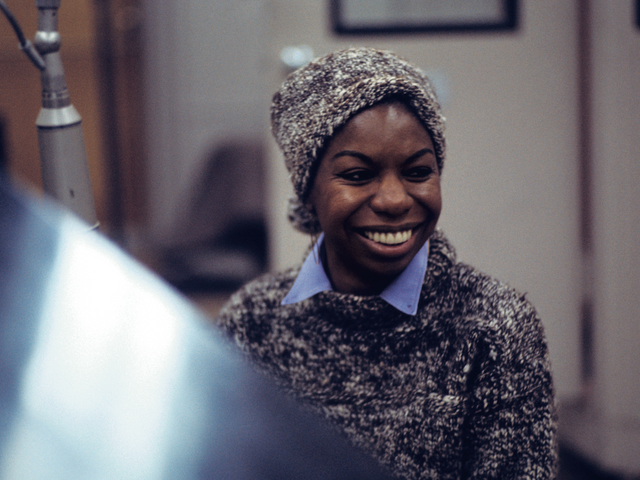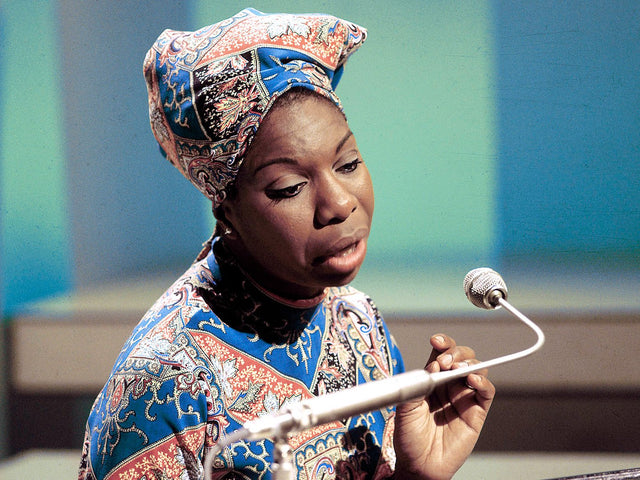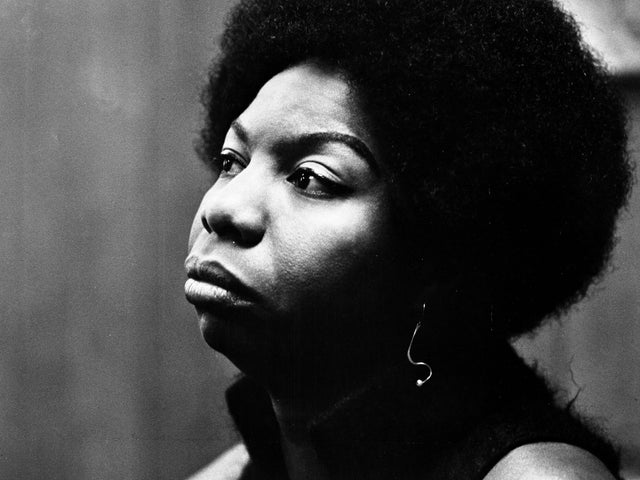Kanye West Sings the Blues
Trying To Decode The Significance Of Kanye Sampling Nina Simone Over His Career
Nina Simone remains one of the most respected and celebrated artists in American history, but she may go down as one of the most sampled as well. Her musings on life, love, liberty, and the Black body have been repurposed and reenvisioned for decades now; such a long line of artists attempting to keep her legacy alive by building upon her blueprint for music that can love you with a clenched fist.
Kanye West is a walking embodiment of the idea, comparing his own music to the morning coffee as a way to kickstart one’s confidence to push through their existence. But the political implications have always been present throughout his catalog too. Perhaps it’s fate that he’s sampled Nina five times in his career, each moment more purposeful and distinct than the last. How does he call upon her, and why? Do his methods change? How is he dialoguing today with yesteryear in an inventive fashion?
In celebration of this month’s VMP release, I dug into those five Kanye records with Nina Simone samples in search of a thread of commonality in their activism for the people and their connection to the spirit as well. There’s times to fight, to retreat, to demand more from oneself as much as the world. I found all of the above to be true, and much more when reflecting on the growth of his oeuvre by the way Ye calls on Nina to frame the power of his words. You’ll find him at his most enraged, dejected, hopeful, and untouchable with Ms. Simone guiding his hand.
"Get By" (2003) -> "Sinnerman" (1965)
Kanye’s first documented Nina sample came before his own breakout as an MC, the pre-College Dropout era where a young Ye was in NYC gettin’ beats off to Hov and anyone else he could work with. On Talib Kweli’s “Get By,” a signature single in Talib's catalog, Kanye uses the Nina interpretation of “Sinnerman,” a piece of traditional Black folk music depicting someone calling on the Lord to fight against their demons and ask for forgiveness. The claps found in the middle of Nina’s piece are flipped percussively, backed by their own melody and a drum break with a pitched-up Nina Simone crying out to the Lord at the very beginning.
The claps and melody are later backed by Talib’s voice and subject matter of perseverance through systemic oppression, capitalism, and the prison-industrial complex among many other issues found in the New York, the America he comes from. Talib extends his own hand to the blues and folk tradition by documenting the plight of his people; the framework from the Nina record is met with a live gospel choir for the chorus, giving a warm, updated texture to the religious overtones found in “Sinnerman.” It’s a perfect storm of symbolism: Black artists paying tribute to their ancestry by updating a tradition with a brand new soul.
"Bad News" (2008) -> "See-Line Woman" (1964)
This piece is a more subtle callback to Nina’s work, focusing much more on the thematics of the original while offering a minimalist bridge to the present. “Bad News” is a remorseful ode to a lover scorned, detailing Kanye’s reaction to learning that his lover’s a cheater who ran off with his heart and defaced the love he had for her. In “See-Line Woman,” Nina sings of a heartbreaking woman who can dress and howl, take a man’s money, and leave him in the dust without a second thought about it. Here, the gender roles shift the context: where Nina’s song comes as a forewarning to the world, Kanye’s song is a first-person account of being a victim of the very woman she sang about all those decades ago, though he claims he wrote some of it from a woman’s perspective.
Kanye’s 808s & Heartbreak period incorporated heavy synth-pop and Auto-Tune before the hip-hop of the era had fully caught on to either as a default mode of creation. Upon the release of 808s, many couldn’t bare to call it a rap album because of the heavy, artful pop space he occupied on the heels of bad romance and the loss of his mother, the late Donda West. The subtlety comes in the drum break: he takes the backing of “See-Line Woman” and basses it up, layering the synths, piano, and strings to give him just enough space to croon. Half the record is a ride-out with no vocals, where Nina’s song emphasized the weight of her voice to fill the space between the sporadic percussion and the men backing her.
"New Day" (2011) -> "Feeling Good" (1965)
Kanye and Jay’s Watch the Throne was a hypercapitalist thrill ride with a few tender moments to spare between the classic moments of maximalist flex rap. “New Day” is that tender outlier, peeling itself away from the album’s grander moments of critique - comparing Iraq to “CHIRAQ” and arguing the case for more Black wealth - to host an insular, personal moment of self-reflection between two men on the brink of fatherhood. As Nina sang of a brand new world, turning to symbols of nature and peace to articulate the freedom of a brand new day, The Throne flipped and pitched her samples again, marking the first time he reorganized her phrases to recontextualize the original intent.
With the help of RZA and Mike Dean, Nina’s chops drive the weighty instrumental through its own uncertainty, back to a triumphant refrain of horns and dark piano. The “new life” and “new day” speaks of a redemption through the next generation. For Kanye, who blames himself for moving his mother to L.A. and ponders forcing Republican ideals on his unborn son to ensure he’s liked by White America. Jay is apologetic for the paparazzi invading his unborn son’s life before he can even take his first steps, and envisions their first drink in the lap of luxury since he’ll never have to sell dope to make it out. Through all their mistakes, amplified for the public, the future of their children becomes the “New Day” as Nina’s optimism provides a guiding light in the darkness.
"Blood on the Leaves" (2013) -> "Strange Fruit" (1965)
I remember reading the song title long before I heard it. I anticipated one of the most poignant political statements of Kanye’s career, with Yeezus arriving on the heels of “New Slaves” projections around the world and several interviews detailing Kanye’s gripes with the racism and classism he faces in all facets of his creativity. This time, he recontextualizes Nina’s version of “Strange Fruit” with a rework of a TNGHT beat to speak on the perils of a relationship gone wrong. The reinterpretation of such harrowing imagery for such a subject matter is questionable at best, but Kanye’s much more confident in pitching Nina’s voice and electing to leave her whole phrases intact throughout the beat.
“Blood on the leaves” and “Leaves” are sampled constantly, the “black bodies swinging in the Southern breeze” are juxtaposed with Kanye’s details about being surrounded by women in lust and passion, and later again as a layer with the interpolation of “Down 4 My Niggas,” referencing the magnolias from “Strange Fruit” as well as the Magnolia projects C-Murder comes from. The piano lingers on, disappearing and reappearing while clashing with the snare patterns and riding by itself during Kanye’s solo outro. Hudson Mohawke - one-half of TNGHT - told Pitchfork: “There’s not an overtly political message in the final lyrics, but in some ways that would’ve been too easy.” But still, there’s plenty to say about the decontextualization of a song about lynching into a trap-inspired song about side bitches where Kanye fans of all races can wait for the drop and initiate the moshpit without even knowing the origin of the sample. Three years since Yeezus and I’ve yet to make the connection myself, but the instrumental execution is of an unfamiliar brilliance.
"Famous" (2016) -> "Do What You Gotta Do" (1968)
In the most timely fashion, “Famous” is Kanye’s most multifaceted Nina reinterpretation to date in terms of shifting the sonic context while maintaining some form of thematic dexterity. It succeeds in ways its predecessor doesn’t: by rearranging Nina’s narrative, having a Black woman pop star interpolating it, and juxtaposing it with another classic record to bring a riveting modernity only hip-hop can provide in such a culture clash. Where “Do What You Gotta Do” is about Nina’s struggle to love someone by letting them go, “Famous” is a commentary on itself, complicating the ideas of love and idolisation of celebrity. It’s an attempt at reclamation of one’s freedom from the clutches of fame and an acknowledgement of everyone’s complicit nature in the whole charade, as evidenced by the confusing video piece with wax figures of famous celebrities all in bed together.
The song begins with Rihanna directly singing Nina’s lyrics as a frame - it even had Young Thug doing the same on an earlier draft - then conjures Rihanna’s voice again for the hook, rearranging a bit of the first verse to shift the perspective. Rihanna could represent herself, a close friend, a crazed fan; the tension lies in such an ambiguity. Nina’s original voice doesn’t appear until the tail end of the second verse, layered underneath the popular sample of “Bam Bam” by Sister Nancy with Swizz Beatz assuming the DJ’s role of rocking the crowd from the record itself. For the first time in Ye’s career, he leaves Nina’s voice from the “Do What You Gotta Do” sample alone, with the lyrics still chopped in reverse order.
Michael Penn II (aka CRASHprez) is a rapper and a former VMP staff writer. He's known for his Twitter fingers.
Join the Club!
Join Now, Starting at $36Pages







